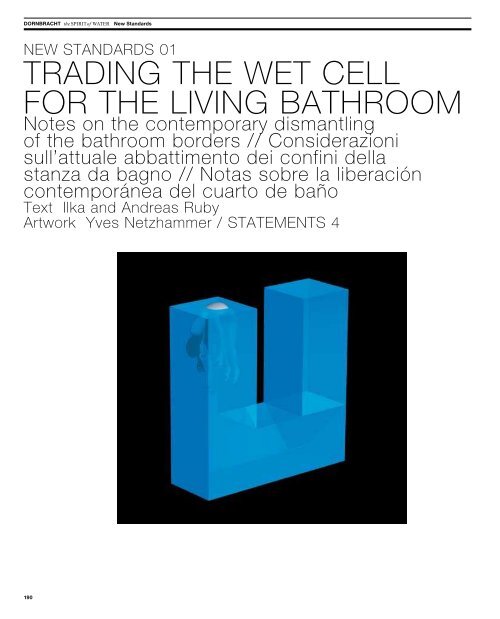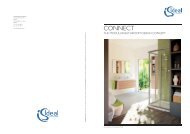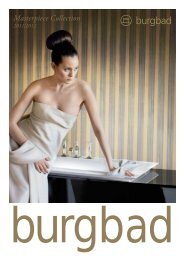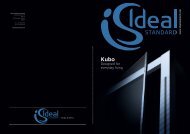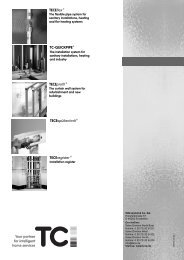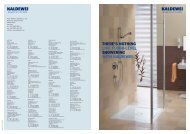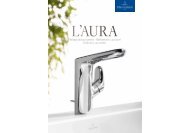productos Dornbracht
productos Dornbracht
productos Dornbracht
Create successful ePaper yourself
Turn your PDF publications into a flip-book with our unique Google optimized e-Paper software.
DORNBRACHT the SPIRITof WATER New Standards<br />
DORNBRACHT the SPIRITof WATER New Standards<br />
NEW STANDARDS 01<br />
TRADING THE WET CELL<br />
FOR THE LIVING BATHROOM<br />
Notes on the contemporary dismantling<br />
of the bathroom borders // Considerazioni<br />
sull’attuale abbattimento dei confini della<br />
stanza da bagno // Notas sobre la liberación<br />
contemporánea del cuarto de baño<br />
Text Ilka and Andreas Ruby<br />
Artwork Yves Netzhammer / STATEMENTS 4<br />
The thought of water in the house is a paradox. As<br />
a descendant of the Arche (German for ‘ark’), architecture<br />
should actually protect us against water.<br />
What we most urgently desire of a house is a roof<br />
over the head. When the Romans used the Latin<br />
word tectum (roof), it was often in reference to the<br />
complete house (L. domus). Although houses do exist<br />
without walls (in the tropics, for example), there<br />
are most certainly no houses without a roof. While<br />
water that falls from the sky is worshipped as a<br />
source of life in agriculture, in architecture it bears<br />
the unfortunate taint of the destructive or transitory.<br />
A leaky roof brings decay and mould, and it can<br />
transform a parquet floor into a grim landscape of<br />
warped wood, curling upwards with such great force<br />
as to snap out of its rigid frame. Nothing disavows<br />
the reputation of architects like water damage; thus,<br />
it is only natural that they expend such an enormous<br />
amount of time on waterproofing their houses. Legion<br />
are the conflicts between builders and architects<br />
over unwanted water. Waterproof or not, that is<br />
here the question – all objections herewith denied.<br />
Physically, water is a torture to architects, if only<br />
because it has proven so difficult to control. Their<br />
toleration of it is less “toleration” than an aesthetic<br />
sublimation. In order to exorcise this suppressed<br />
“aquaphobia”, they surround their constructions<br />
with reflecting ponds or swimming pools because<br />
here, at long last, water serves to mirror the architect’s<br />
creation, optically multiplying it.<br />
In this way, as an exception to the normative drybuilding<br />
regime, the bathroom seems but a tolerated<br />
anomaly. It is the only room in the house permitted<br />
to be really wet. As a technical concept of the modern<br />
bathroom, this “wet cell” must be taken literally<br />
– it is a room in which water is held captive. Within<br />
the domestic world, the bathroom appears to be a<br />
heterotopia. Here, water is symbolically cleansed of<br />
the negative connotations clinging to it beyond the<br />
borders of the bathroom. Indeed, the contemporary<br />
bathroom cult would seem to be proliferating in tandem<br />
to the growing concerns associated with water<br />
in its natural environment:<br />
Water has become scarce: In the coming decades,<br />
the scarcity of drinking water in many developing<br />
countries will cost millions of lives or force their<br />
inhabitants to migrate millions of miles, which<br />
should produce a consciousness in persons of the<br />
“developed” countries to use their resources more<br />
sparingly. This “should” has yet to make its mark<br />
legible. As ever, those prototypical Californian suburban<br />
front lawns are artificially irrigated, as if the<br />
view of green grass has become yet another indispensable<br />
fact of life. But even here in “enlightened”<br />
Europe, despite ecologically correct aspirations, we<br />
should be getting stomach aches for all of the drinking<br />
water used for flushing toilets – as a rule, our<br />
houses have no separate plumbing for service water.<br />
Water has become a commodity: For Nestlé, the<br />
leading international brand in the table water business<br />
(in essence, bottled tap water), drinking water<br />
has long been considered a commodity like any<br />
other. Because the economically rich countries of<br />
the north are also rich in water, in the future they<br />
will be the shareholders of the water monopoly. Indeed,<br />
a profitable source of capital when one considers<br />
the fact that economists are already calling<br />
water the oil of the 21 st century. It only follows economic<br />
rhyme or reason that the water-rich countries<br />
will exploit this monopoly too – after all, until now,<br />
every other country has had no qualms in putting<br />
their own natural resources such as oil and natural<br />
gas to their own advantage. The arid countries of the<br />
South, and Africa in particular, already suffering<br />
from a lack of food and from the expansion of the<br />
desert (as a result of the climate catastrophe), will<br />
undoubtedly suffer all the more from a lack of<br />
drinking water.<br />
Water produces catastrophes: Without water, one<br />
cannot live, but with too much, one can hit rock<br />
bottom just as well. The steadily melting poles have<br />
affected an increase in the sea level as such that<br />
entire islands in the Pacific will disappear 1) and a<br />
number of populated coastal regions throughout the<br />
world will be devoured by the sea. Because these<br />
coastal regions are also frequently seats of industry,<br />
the economies connected to them will be severely<br />
damaged as well. Storm floods and inundations of<br />
all strengths will become more the rule than the<br />
exception. Water, from sky or sea, is becoming a<br />
permanent threat.<br />
Naturally, one doesn’t think about all this when one<br />
turns on the bathroom tap, and it is exactly in this<br />
repression that the contemporary cultural function<br />
of the bathroom lies. It is the space of transfiguration<br />
and transformation. Therein, it resembles the<br />
White Cube, the normative art showroom of the<br />
modern. The White Cube temporarily suspends<br />
everyday life: it lets the usual appear unusual and<br />
transforms our perception of reality. That the classic<br />
modern bathroom is just as white as the White Cube<br />
underscores its secret complicity. Certainly, it was<br />
no coincidence that Marcel Duchamp chose an urinal<br />
as a manifestation of the transformation of an<br />
everyday life object into a work of art based on the<br />
principle of the objet trouvé (Fountain, 1917). The<br />
bathroom, thus, performs a similar transformation<br />
with us. It is the place of physical twilight – the<br />
space between sleep and wakefulness. It is a lock,<br />
where the forgotten-self, teetering on the edge of the<br />
empire of dreams, is transformed into the “I”<br />
frequently encountered only by the first glance in<br />
the mirror. It is the room in which the making of<br />
oneself up is a form of exerting control over the “I”,<br />
and where we transform ourselves into the “I” we<br />
wish to produce.<br />
To this extent the bathroom is an extremely private<br />
space. Likewise, this private space is often shared<br />
with other members of the family. Unlike the bedroom,<br />
which, as a rule, is allocated to a person or to<br />
intimate life partners, the bathroom functions like a<br />
time-shared private-public space. Which is why it<br />
can lead to conflicts between family members or flat<br />
mates, as the bathroom grants privacy like perhaps<br />
no other domestic room, albeit, enjoyed for a limited<br />
time only.<br />
To this extent, the functionalist all-in-one bathroom<br />
plays an important role in the habits and unwritten<br />
rules of co-habitation. It conditions the<br />
underlying image of individuality and collectivity<br />
of the inhabitants who share a flat. This psychosocial<br />
function has been put up for grabs, so to<br />
speak, given the spatial transformation the bathroom<br />
has been going through for some years now.<br />
When seen against the background of the wellness<br />
boom of recent years, the functionalist “bath cell”<br />
has become yet another discontinued model. Today,<br />
the bathroom is not only a space of corporeal hygiene,<br />
but of relaxation. The bathroom, hence, becomes<br />
more of a “living” room: that one can observe<br />
this phenomenon more and more in<br />
contemporary “lifestyle” living, seems only a natural<br />
consequence. The question is what new psychosocial<br />
behaviours will result from this integrated<br />
bathing. It is especially interesting that the typology<br />
of the “living bathroom” has been developed,<br />
above all, in hotel design. Architects and designers<br />
have made the hotel bathroom their laboratory of<br />
trial and error: here, they could test out new relationships<br />
between bathing and living spaces, without<br />
having to pay too much consideration to established<br />
conventions. After all, no one lives in a hotel<br />
forever. On the contrary, the hotel is where we have<br />
come to expect deviations from our domestic<br />
norms; at home, we can still live according to those<br />
implacable rules of convention. And because, as a<br />
rule, the hotel room represents a “private” sphere,<br />
we are almost inevitably more willing to take risks<br />
in this kind of “test-drive” living than we are at<br />
home – perhaps because it is only here that we can<br />
avoid the prying questions of the inquisitive guest.<br />
The more courageous of us all have already asked<br />
themselves whether or not one might bring these exciting<br />
bathing experiences home in order to transform<br />
their domestic living culture into something<br />
more cutting edge. Certainly, if one integrates the<br />
bathroom into the living space, not only is the space<br />
of bathing changed but also that of “living”. Actions<br />
and persons who were previously spatially separated,<br />
must once again stand side-by-side and let negotiations<br />
begin. When, for example, in the Hotel Amerigo<br />
in Alicante, the wash basins are transplanted from<br />
the bathroom to the corridor, a direct relationship<br />
between undressing (in front of the sink) and dressing<br />
(in front of the wardrobe directly beside it)<br />
emerges. When a landscape of seating possibilities<br />
flows seamlessly into the lip of the bathtub, like in<br />
the Hotel Q in Berlin, one wonders how it effects the<br />
conversation over tea. And when the double bed is<br />
separated from the shower only by a transparent<br />
glass wall, like in the Standard Hotel in downtown<br />
Los Angeles, entirely new perspectives of seduction<br />
are made possible.<br />
190<br />
191


